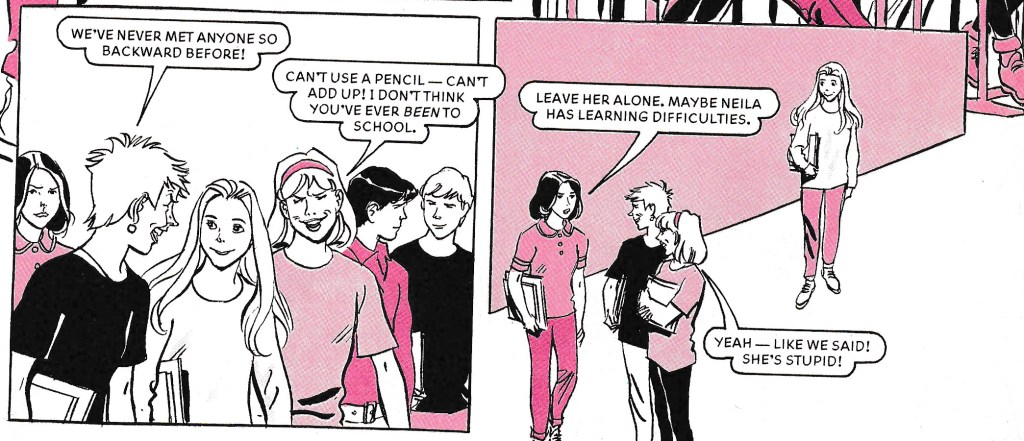
FIRST DISCLAIMER: It is not known if any of the creators have confirmed that the characters mentioned have any form of neurodiversity or show any traits of it (apart from the slight hint of Neila from The New Girls! having learning difficulties). My findings of their traits are based on my own opinions as well as those of one of my friends and my mother. I also found dyspraxia traits in Lizzie Smith retrospectively, i.e. Lizzie’s New Life is set in the 1850s and dyspraxia was first identified as congenital maladroitness in the 1900s, but it wasn’t known as dyspraxia until the 1960s.
Introduction
I have been dipping in and out of the world of girls’ comics and annuals for just over 24 years. While I have already written posts about the Bunty for Girls 1999 annual, I have re-visited this annual and read other girls’ comic annuals in my collection to see if there were any characters who had neurodiversity traits (e.g. those of autism, ADHD, dyslexia and dyspraxia; although some may show traits of less common forms of neurodiversity such as dyscalculia and dysgraphia).
Here are the characters I could find and the neurodiversity traits that I could identify in them. I have listed the characters in chronological order of the publications they originally appeared in (WARNING: The story summaries may contain spoilers!).
Flossie White from The Unwanted Flowergirl (originally from the Bunty for Girls 1961 annual that I do not own. It was reprinted in the first Bunty for Girls Golden Age Classic Stories book from 2009 that I do own)
Artist: Unknown
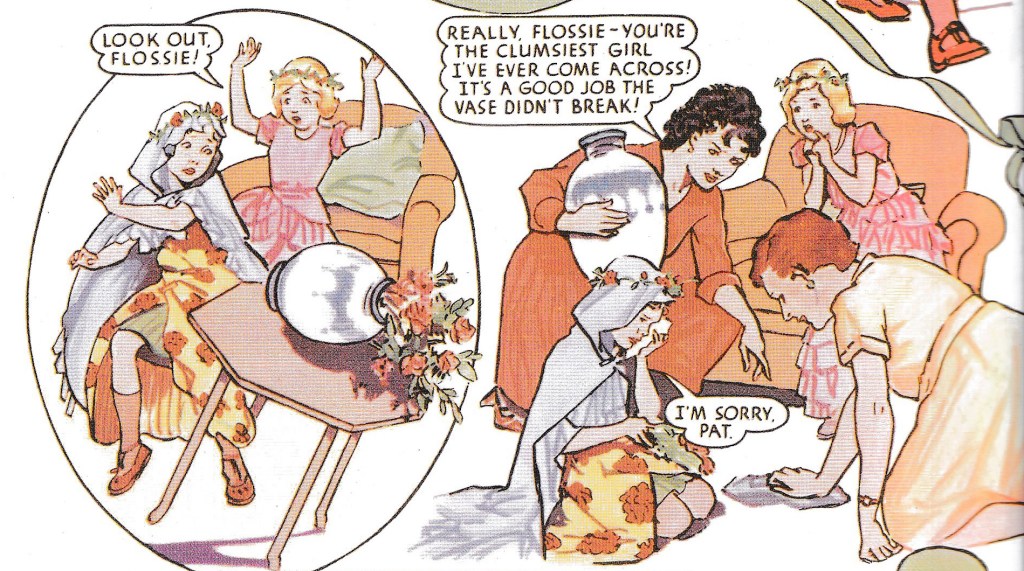
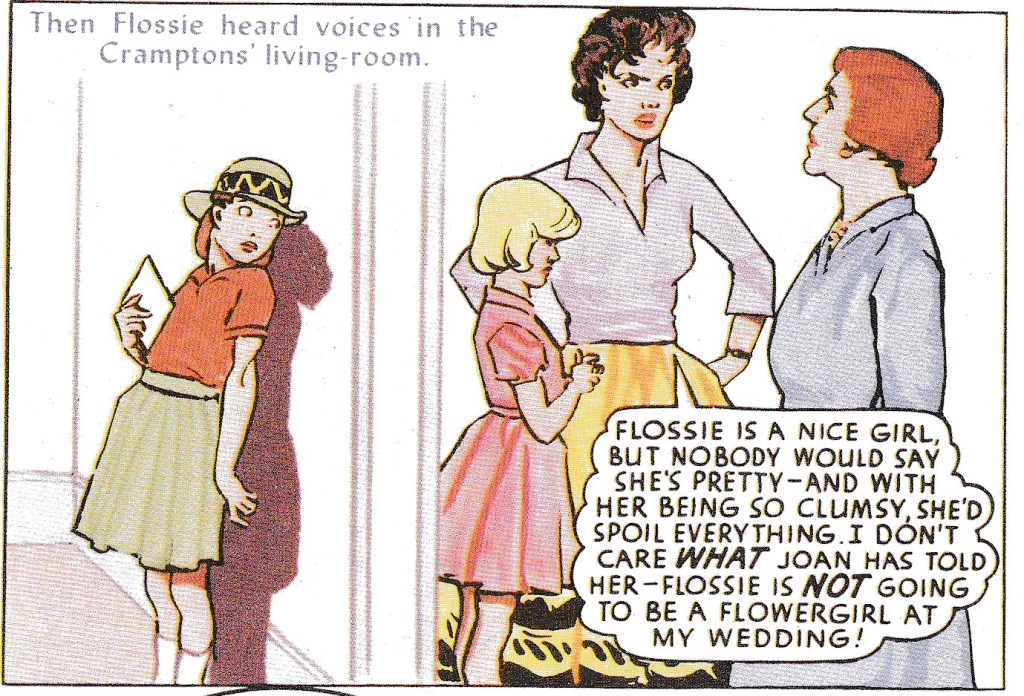
Flossie and her friend, Joan Crampton, play a game of “Weddings.” During the game, Flossie knocks into a table and a vase of flowers falls from it. Joan’s older sister, Pat, is going to get married in three weeks’ time but she doesn’t want Flossie to be a flower girl at her wedding due to her clumsiness (a common trait in dyspraxia). Flossie is devastated to hear this. Despite what Pat had said, Flossie continues to play with Joan but they don’t talk about the upcoming wedding. When Flossie revisits the Cramptons, she sees Pat’s wedding dress. The fireplace suddenly sparks and sets the tissue in the box the dress was in alight. Flossie puts out the fire with her bare hands in a desperate attempt to save Pat’s dress. Because Pat is extremely grateful for Flossie saving her dress, she wants her to be a flower girl after all.

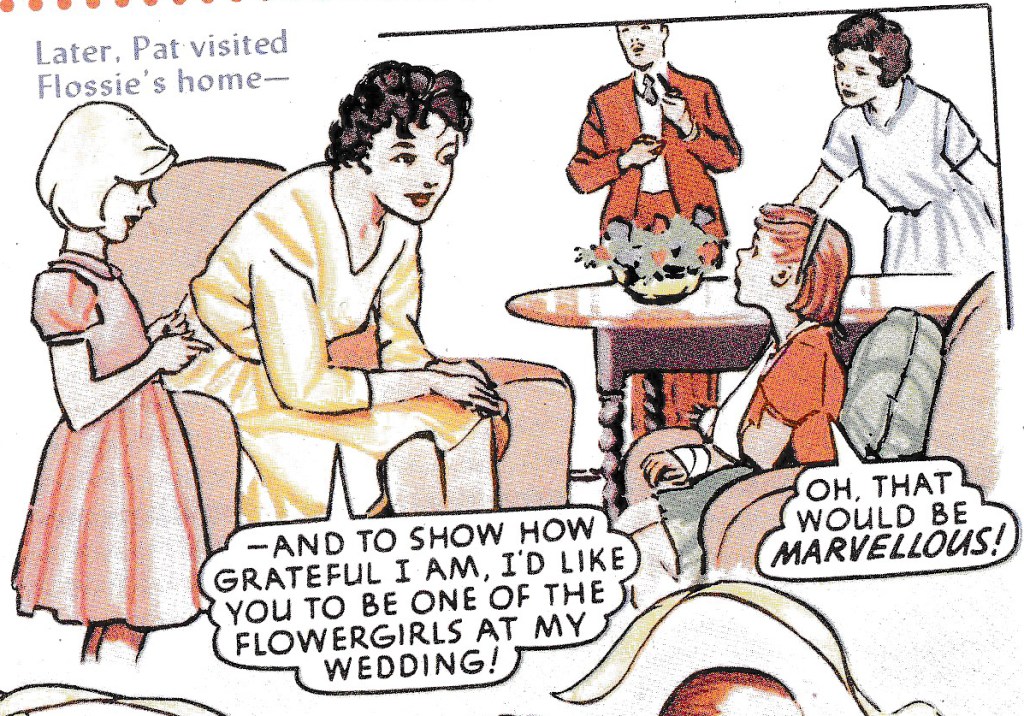
While clumsiness is a common dyspraxia trope (it was given the cruel nickname of Clumsy Child Syndrome from 1975 until 1989), it was courageous of Flossie to save Pat’s wedding dress from burning even though Flossie burnt her hands in the process.
Aggy Pritchard from the Lorna Drake series in Bunty comics and annuals
Artist: Tony Thewenetti


Lorna Drake is the only pupil at Thelma Mayne’s Ballet School. She and her friend, Aggy, are both chosen to dance in the operetta for a parents’ night in the instalment that was originally printed in an unknown issue of the weekly Bunty comic (it was reprinted in the second Bunty for Girls Golden Age Classic Stories book from 2010). Aggy is as clumsy as an ox (again, dyspraxia). This is definitely proven when her school books fall from her bike as she rides away and again when she kicks the cushion that represents the fire off the stage during the dress rehearsal for the operetta. Miss Mayne then tells Aggy she is out of the operetta because she is too clumsy to be a dancer. Aggy is very upset about this, but Lorna is determined to get her back in the operetta.
Another trait of dyspraxia is finding it hard to dance due to co-ordination issues. Even though Aggy seems to dance pretty well, her clumsiness hinders her chances of performing on parents’ night.
Debbie’s younger sister, Maisie, from Little Sis in the Debbie for Girls 1980 annual
Artist: Doris Kinnear

Little Sis (known in the weekly Debbie comic as Debbie and Maisie) follows the shenanigans of the comic’s namesake, Debbie, and her younger sister, Maisie. In this first strip in the Debbie 1980 annual, Debbie gives Maisie instructions such as, “put on the tablecloth,” but Maisie takes them very literally (a common trait in autism) by putting the tablecloth on herself rather than on the table for instance. At the end, Maisie is struggling with her homework and asks Debbie to give her a help. To turn the tables on Maisie (metaphorically speaking), Debbie writes, “HELP,” on a big piece of paper and shows it to Maisie, much to her shock.
This is an amusing strip where Maisie takes Debbie’s instructions literally. I like how girls’ comics and annuals had humour strips that revolved around their namesakes. Other girls’ comics and annuals that had humour strips based on their namesakes were Bunty, Mandy, Judy and Mandy & Judy (later known as M&J).
Marie Reagan from A Fast Learner in the Judy for Girls 1984 annual
Artist: Rodney Sutton
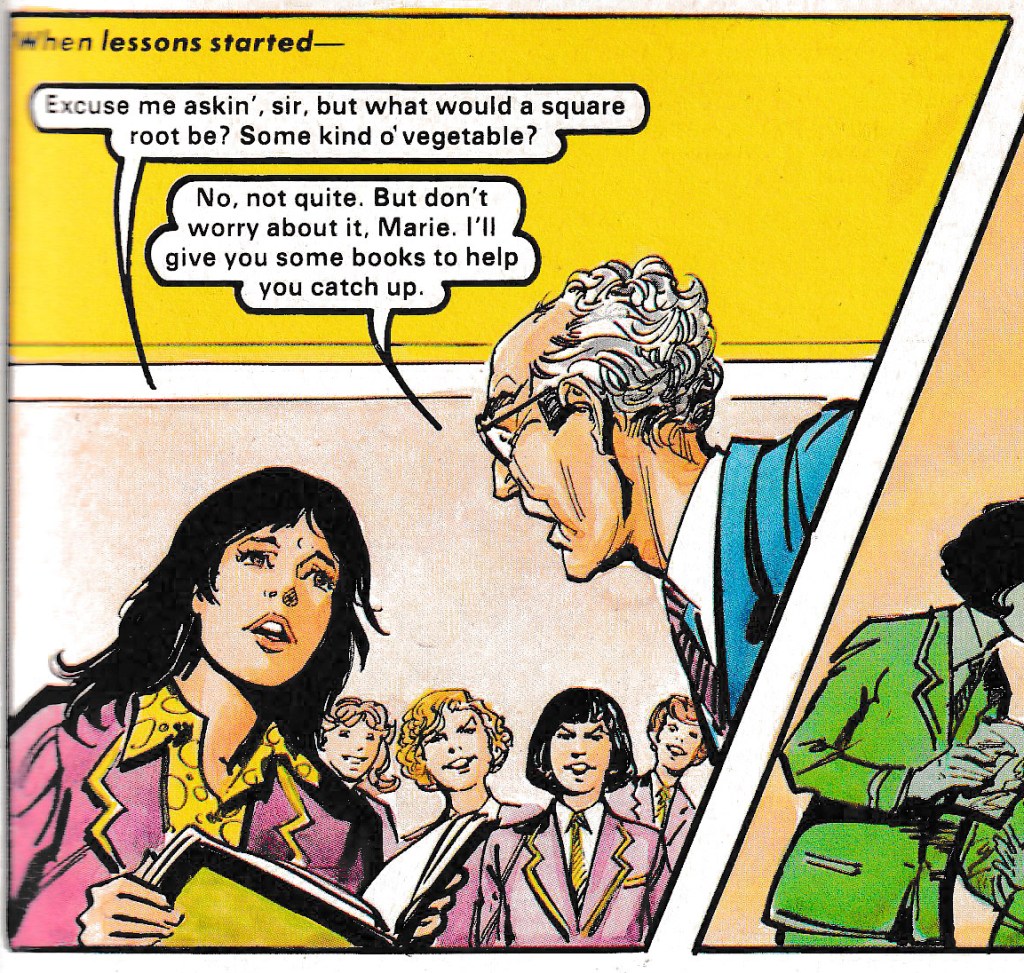
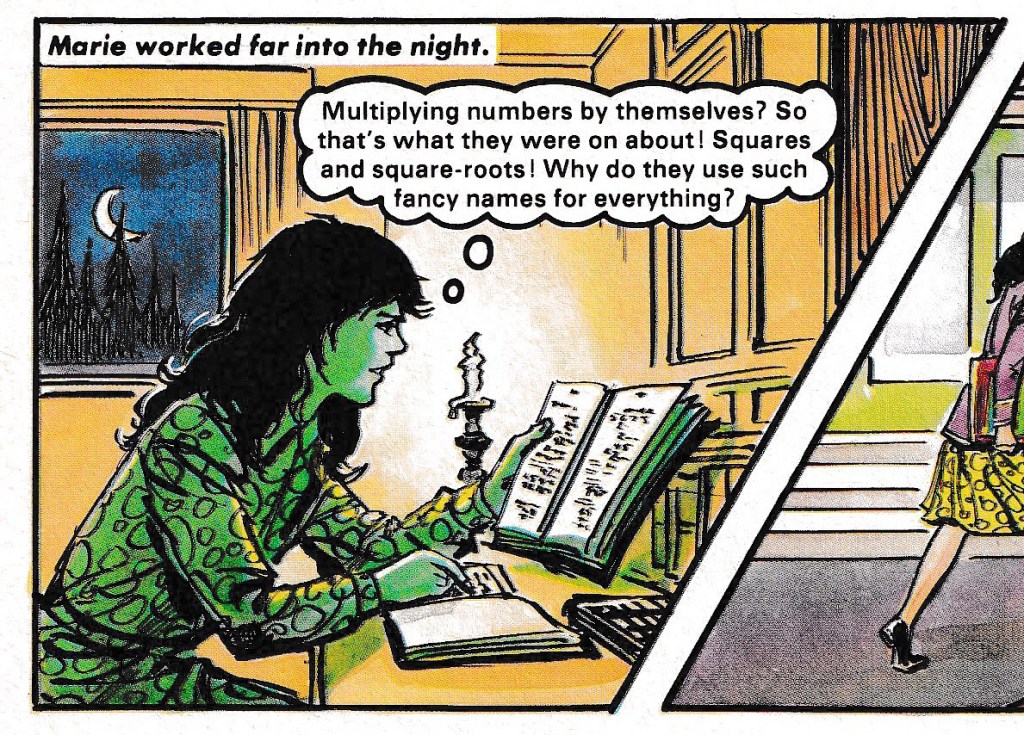
Marie had travelled with her family all her life. One day, she is told she has to start school. On her first day, Marie asks her teacher if a square root is a kind of vegetable. This could imply that Marie has autism due to her thinking that a mathematical function is a root vegetable. She could also have dyscalculia due to not seeming to understand the concept of maths. Despite her difficulties, her dad taught her while they were travelling. When Marie studies into the night, she discovers that squares and square roots involve multiplying numbers by themselves (for example, the square root of 16 is 4 because 4 x 4 = 16). Marie eventually takes an hour-long maths test that she excels in. Although Marie’s teacher tells her she is a fast learner, she admits that she is not as fast a learner as her parrot, Poll, is, especially when Poll witnesses some bullies planting some stolen sweets in Marie’s locker in an attempt to get her expelled from the school.
Not only could Marie initially not understand the concept of square roots due to her possible autism and dyscalculia, but her dad most likely did not teach her that area of maths.
Mary Radleigh AKA Raddy and Mary Simpson AKA Simpy from The Four Marys story in the Bunty for Girls 1987 annual
Artist: Selby Donnison


Mr. Lentham, the father of Third Form snob Mabel Lentham, opens a new sports wing at St. Elmo’s School for Girls. Some other teams of girls compete in sports against the St. Elmo’s girls including those from the village of West Mead. Dr. Robertson, a former university lecturer of languages, coaches the West Mead girls. The West Mead girls are in danger of losing their sports field because the Duke of Wessex has sold it to Sir William Smithers and Sir William has sold it to Mr. Lentham, who plans to build some houses on it. The West Mead girls and the Marys protest against the West Mead girls losing their field (Raddy writes, “Sport not bungle-owes,” on one of her placards, which could be seen as a dyslexic trait even though Raddy insists that the spelling is correct). Unfortunately, the protesting leads to Dr. Gull, the headmistress of St. Elmo’s, making the Marys write 500 lines about behaving with dignity in the library on their next half-day. This leads to the Marys missing out on a history field trip. Whilst in the library, they look through a box of old Wessex papers. The oldest paper is written in what Raddy and Simpy think is Latin until Dr. Robertson says it’s actually written in old English. Dr. Robertson explains that the paper says Leofric, the then-Earl of Wessex (he was actually the Earl of Mercia), granted the field, also known as the Meadow, to the villagers of West Mead as long as a weapon-showing was held on it every year. Simpy suggests that she, the other Marys and the West Mead girls hold their own weapon-showing on the field in order to save it. The Marys pitch this idea to Dr. Gull and Mr. Lentham. Mr. Lentham agrees with the idea little knowing that it’s a set-up to prevent him from building the houses. The weapon-showing and more sports take place on the field, which means that the West Mead girls can keep it for at least another year.
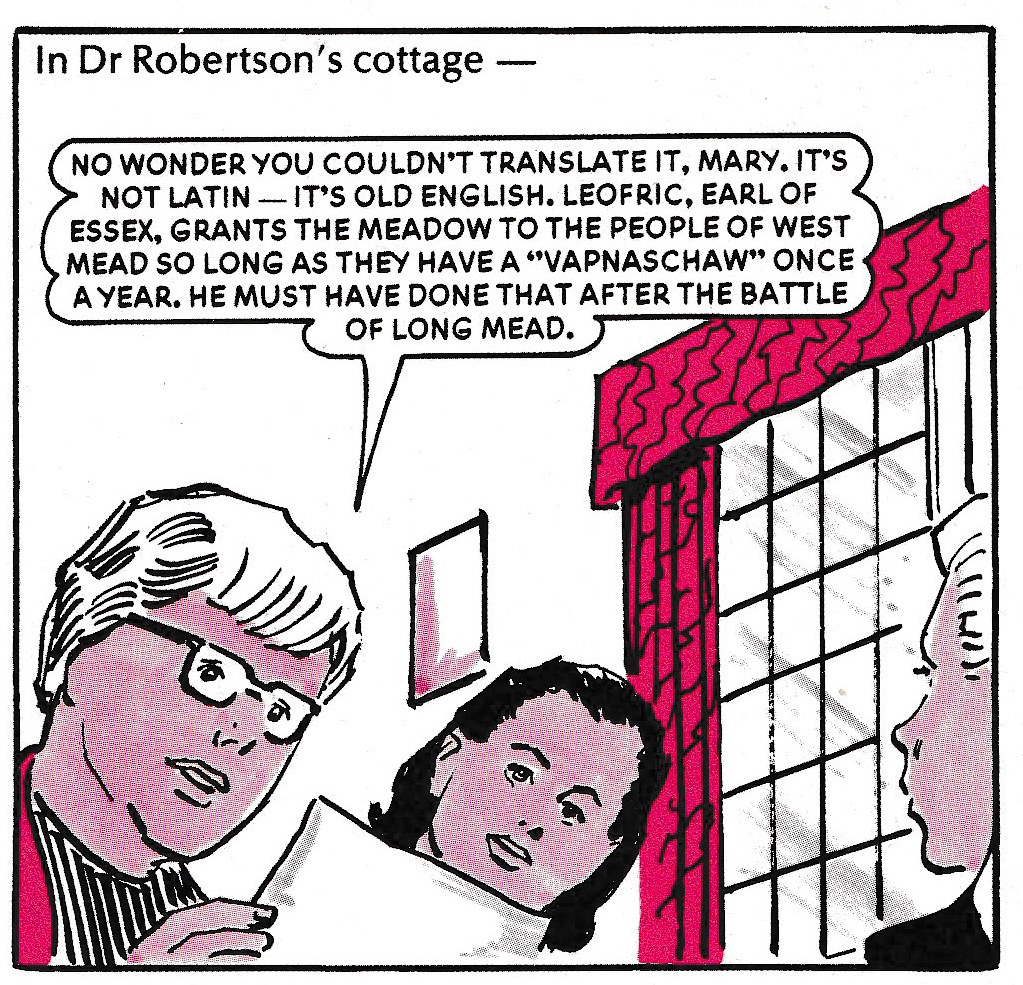
Although Raddy insists that she was supposed to have written, “bungle-owes,” on her placard, it could also foreshadow Mr. Lentham’s plans to build the houses on the field and be a pun on him building them in a clumsy and incompetent manner as well as him owing the field or the houses to the Duke of Wessex and Sir William. Simpy can’t read the majority of the old paper apart from a word that looks like, “common,” which represents the dyslexic trait of struggling to learn foreign or old-fashioned languages.
Tina Wilson from Watch What You Tell Tina! in the Mandy for Girls 1988 annual
Artist: Andrew Wilson


The Wilsons (interesting how they have the same surname as the artist who illustrated this story!) are a happy if hard-up family. The middle child, Tina, is a right little character who takes expressions literally and seriously (again, a common autistic trait). For example, when Tina’s mum tells her she has to have a run round the table since they are short of food, Tina actually does run around the table, much to the amusement of her family! Tina could also show signs of ADHD due to her running around the table and not wanting to sunbathe (hyperactivity); shovelling sand on her dad against his will (impulsivity); and swapping her baby brother, Colin, for a bike belonging to a girl named Maxine (again, impulsivity) so that there will be one less mouth to feed. Luckily, Colin is reunited with his family and his dad gets a job for an electricity firm thanks to Maxine being the daughter of the man who owns the firm.
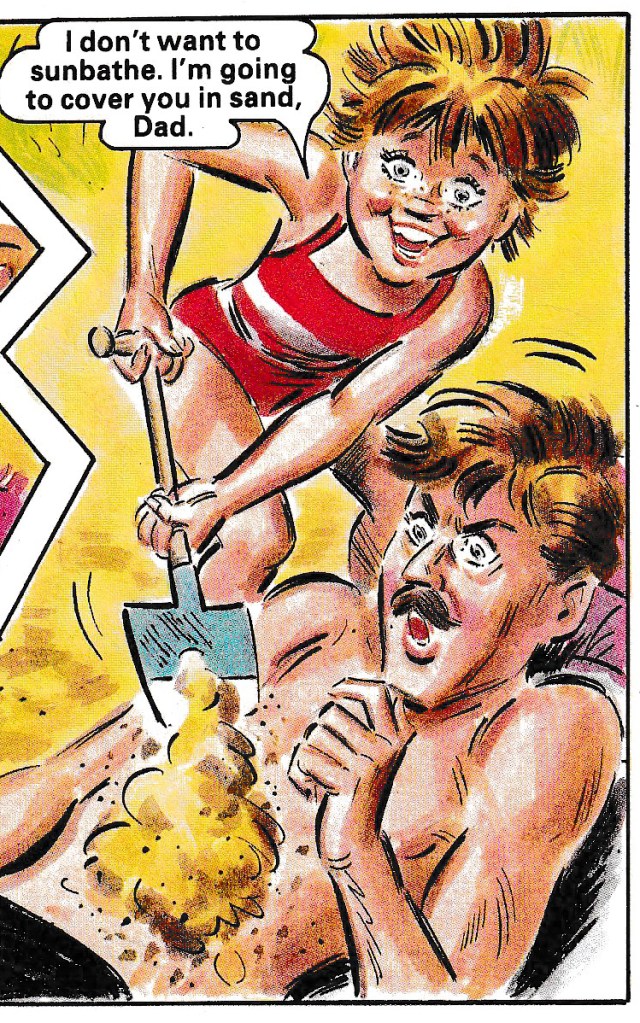
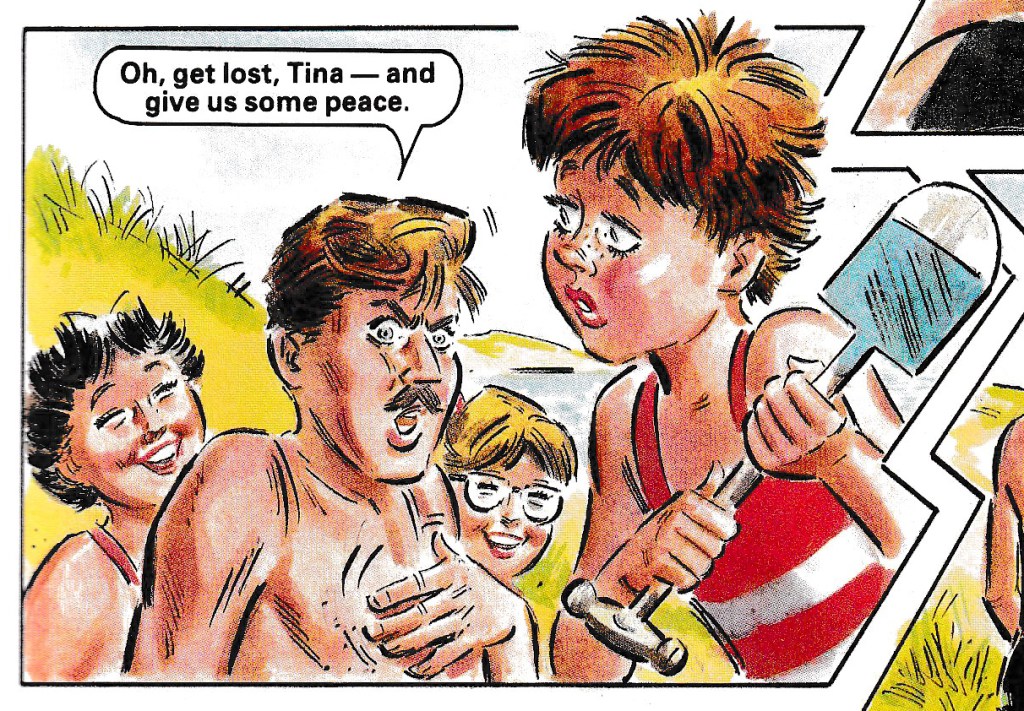

While Tina could possibly show signs of autism as well as the hyperactive and impulsive traits of ADHD, she doesn’t seem to show any inattentive traits of ADHD.
Claudia Coleridge from Clumsy Claudia in the Bunty for Girls 1997 annual
Artist: Andy Tew


Claudia is a successful teenage model, but she is terribly accident-prone. She spills her coffee, knocks a cleaning trolley over, squirts some tomato ketchup on her friend, gets her umbrella stuck in another model’s and gets paint in her hair. Because the paint won’t budge, Claudia decides to have her hair cut short. Although Claudia no longer feels herself with her new short haircut, some people who interview her at a casting find who they’re looking for – a girl with short hair. Claudia gets the job of modelling for a popular teen fashion department, much to her delight.
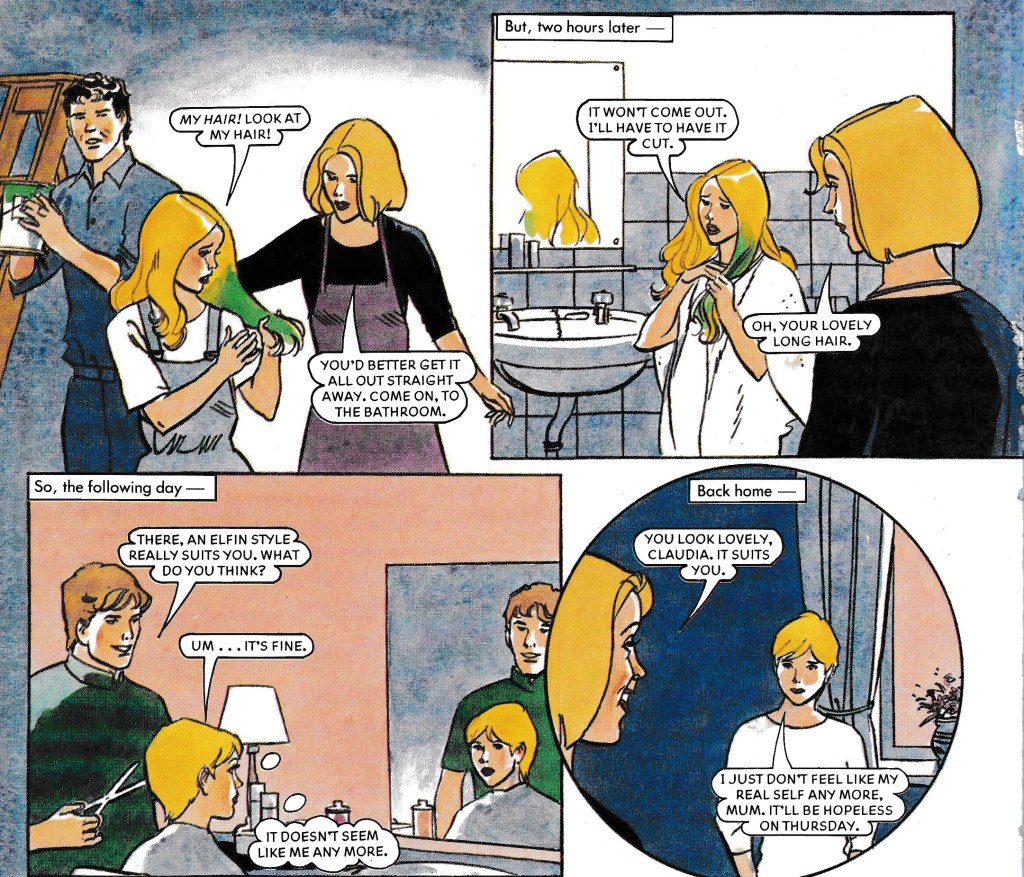
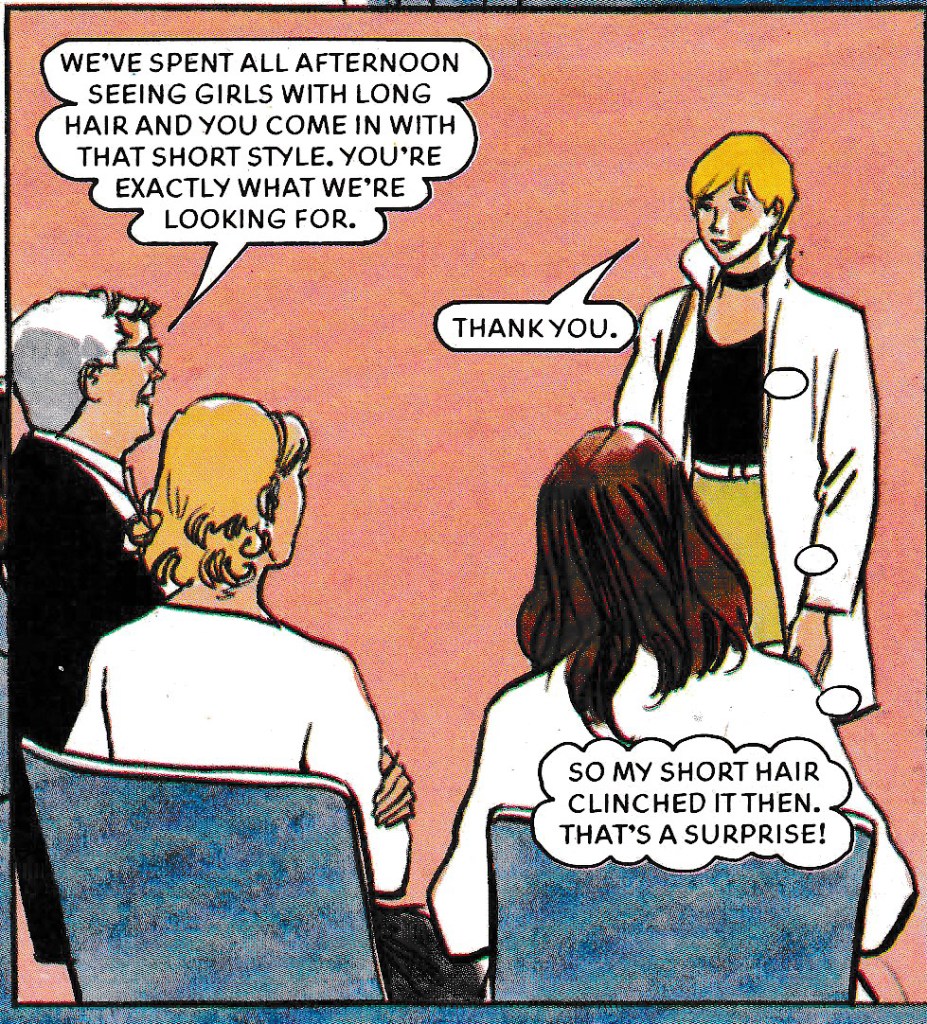
Even though Claudia shows dyspraxic traits, she thinks she wouldn’t have landed the job if she wasn’t acccident-prone.
Neila from The New Girls! in the Bunty for Girls 1998 annual
Artist: Andy Tew


Two new girls, Paula Peterson and Neila, start at the famous Dinelli Stage School. Neila holds her pencil upside down (dysgraphia), writes her numbers in a wobbly fashion (again, dysgraphia), doesn’t seem to understand basic maths (dyscalculia) and thinks she will struggle to read the script for Peter Pan (dyslexia). Two other girls, Kelli and Stacey, call Neila, “backward,” but Paula suggests that Neila has learning difficulties. Despite Neila’s poor academic skills, she is an amazing dancer and actress. Neila is given the titular role of Peter Pan and despite Miss Rossi saying that Neila needs wires for the ‘flying’ scenes, she flies without them in her final flying scene, much to the astonishment of Paula, Kelli and Stacey. Paula asks Neila how she was truly flying. Neila says that Stacey and Kelli were right when they called her, “backward,” especially when it comes to her name. Paula then learns that Neila is an alien (Neila is, “alien,” spelt backwards) and Neila reveals that she came to Earth to learn to be an actress since there are no stage schools on her home planet.
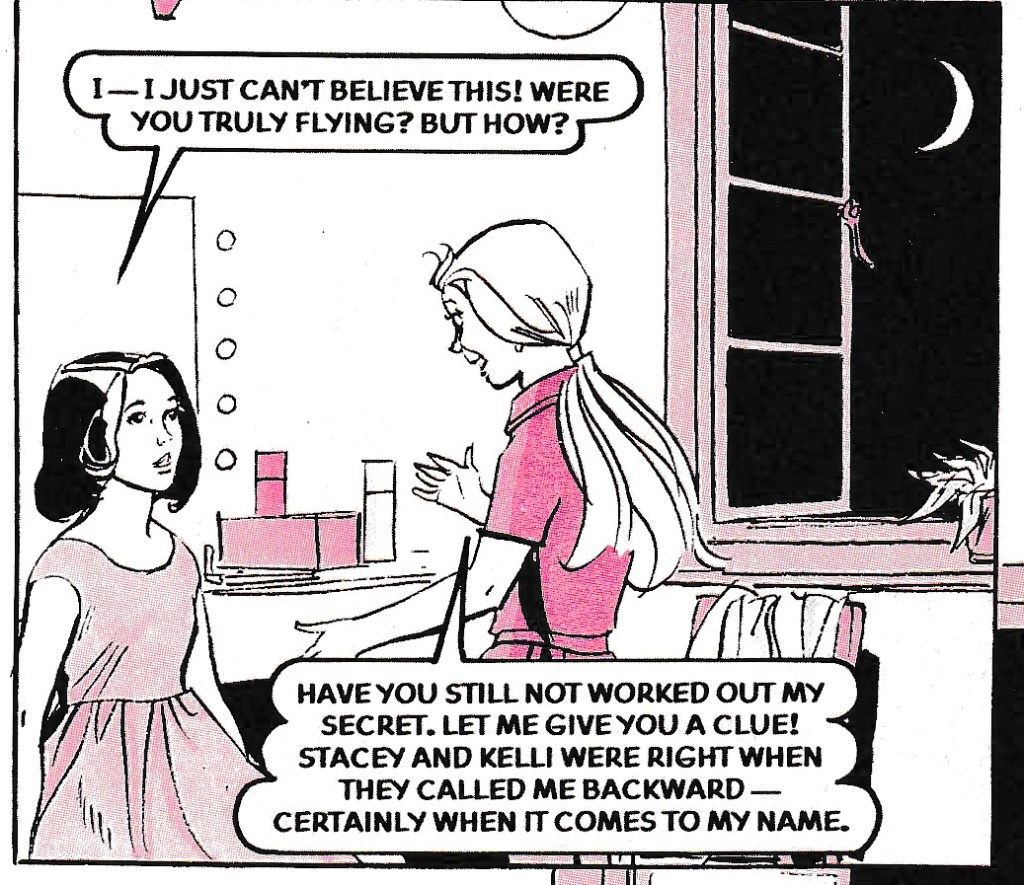
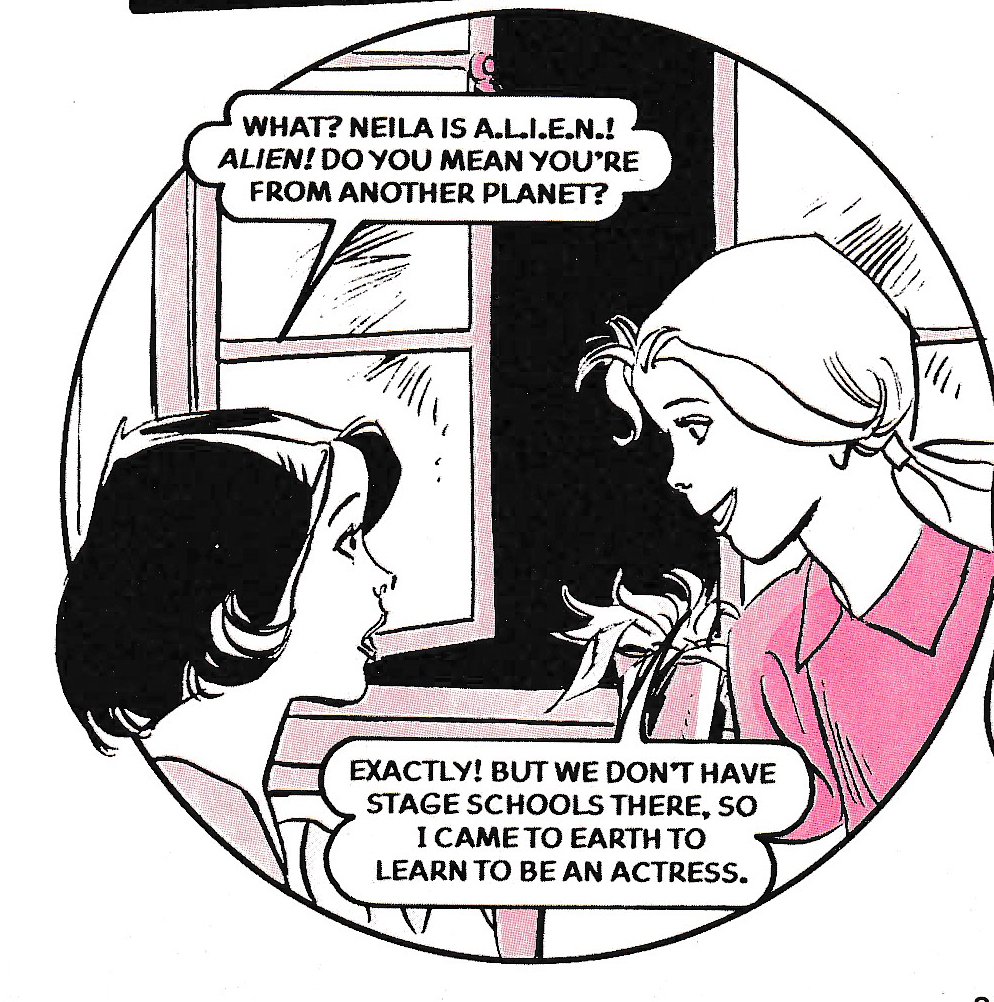
Neila’s identity as an alien could also be the reasons why she holds her pencil upside down, writes her numbers in a wobbly fashion and can’t do basic maths. Dysgraphia, dyscalculia and dyslexia can all be perceived as learning difficulties although they can also be looked upon as learning differences.
Lizzie Smith from Lizzie’s New Life in the Bunty for Girls 1999 annual
Artist: Don Walker


I have already discussed Lizzie’s New Life in greater depth in Part 2 of my picture stories in the Bunty 1999 annual blog post, but I would like to point out that Lizzie seems to show traits of dyspraxia in this post. These include using the wrong knife at dinner and struggling to follow a dance routine at a dancing class. Lizzie could also struggle to use the correct knife and follow the dance routine because she is transitioning from her poor life to a more upper class life.
Conclusion
The most common traits that these girls’ comic and annual characters have shown are those of dyspraxia (Flossie, Aggy, Claudia and Lizzie). Autistic traits (Maisie, Marie and Tina) and dyslexic ones (Raddy, Simpy and Neila) are the next most common followed by those of dyscalculia (Marie and Neila), dysgraphia (Neila) and ADHD (Tina).
OTHER DISCLAIMERS
This is not a sponsored blog post.
The images used in this blog post belong to D.C. Thomson & Co., Ltd., although I have made my own scans of them.
